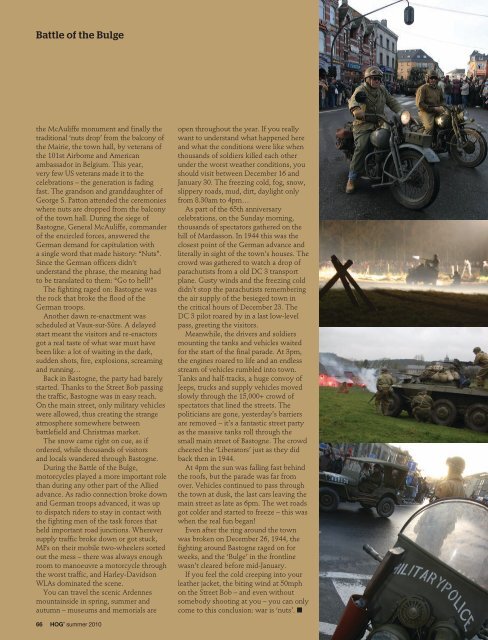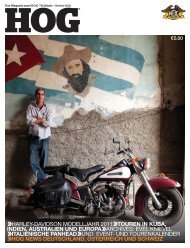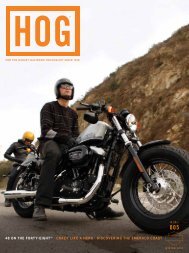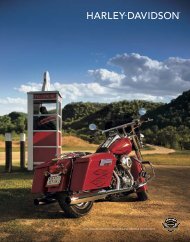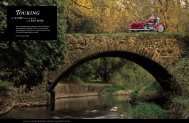HOG - Harley-News
HOG - Harley-News
HOG - Harley-News
Create successful ePaper yourself
Turn your PDF publications into a flip-book with our unique Google optimized e-Paper software.
Battle of the Bulge<br />
the McAuliffe monument and finally the<br />
traditional ‘nuts drop’ from the balcony of<br />
the Mairie, the town hall, by veterans of<br />
the 101st Airborne and American<br />
ambassador in Belgium. This year,<br />
very few US veterans made it to the<br />
celebrations – the generation is fading<br />
fast. The grandson and granddaughter of<br />
George S. Patton attended the ceremonies<br />
where nuts are dropped from the balcony<br />
of the town hall. During the siege of<br />
Bastogne, General McAuliffe, commander<br />
of the encircled forces, answered the<br />
German demand for capitulation with<br />
a single word that made history: “Nuts”.<br />
Since the German officers didn’t<br />
understand the phrase, the meaning had<br />
to be translated to them: “Go to hell!”<br />
The fighting raged on: Bastogne was<br />
the rock that broke the flood of the<br />
German troops.<br />
Another dawn re-enactment was<br />
scheduled at Vaux-sur-Sûre. A delayed<br />
start meant the visitors and re-enactors<br />
got a real taste of what war must have<br />
been like: a lot of waiting in the dark,<br />
sudden shots, fire, explosions, screaming<br />
and running…<br />
Back in Bastogne, the party had barely<br />
started. Thanks to the Street Bob passing<br />
the traffic, Bastogne was in easy reach.<br />
On the main street, only military vehicles<br />
were allowed, thus creating the strange<br />
atmosphere somewhere between<br />
battlefield and Christmas market.<br />
The snow came right on cue, as if<br />
ordered, while thousands of visitors<br />
and locals wandered through Bastogne.<br />
During the Battle of the Bulge,<br />
motorcycles played a more important role<br />
than during any other part of the Allied<br />
advance. As radio connection broke down<br />
and German troops advanced, it was up<br />
to dispatch riders to stay in contact with<br />
the fighting men of the task forces that<br />
held important road junctions. Wherever<br />
supply traffic broke down or got stuck,<br />
MPs on their mobile two-wheelers sorted<br />
out the mess – there was always enough<br />
room to manoeuvre a motorcycle through<br />
the worst traffic, and <strong>Harley</strong>-Davidson<br />
WLAs dominated the scene.<br />
You can travel the scenic Ardennes<br />
mountainside in spring, summer and<br />
autumn – museums and memorials are<br />
open throughout the year. If you really<br />
want to understand what happened here<br />
and what the conditions were like when<br />
thousands of soldiers killed each other<br />
under the worst weather conditions, you<br />
should visit between December 16 and<br />
January 30. The freezing cold, fog, snow,<br />
slippery roads, mud, dirt, daylight only<br />
from 8.30am to 4pm…<br />
As part of the 65th anniversary<br />
celebrations, on the Sunday morning,<br />
thousands of spectators gathered on the<br />
hill of Mardasson. In 1944 this was the<br />
closest point of the German advance and<br />
literally in sight of the town’s houses. The<br />
crowd was gathered to watch a drop of<br />
parachutists from a old DC 3 transport<br />
plane. Gusty winds and the freezing cold<br />
didn’t stop the parachutists remembering<br />
the air supply of the besieged town in<br />
the critical hours of December 23. The<br />
DC 3 pilot roared by in a last low-level<br />
pass, greeting the visitors.<br />
Meanwhile, the drivers and soldiers<br />
mounting the tanks and vehicles waited<br />
for the start of the final parade. At 3pm,<br />
the engines roared to life and an endless<br />
stream of vehicles rumbled into town.<br />
Tanks and half-tracks, a huge convoy of<br />
Jeeps, trucks and supply vehicles moved<br />
slowly through the 15,000+ crowd of<br />
spectators that lined the streets. The<br />
politicians are gone, yesterday’s barriers<br />
are removed – it’s a fantastic street party<br />
as the massive tanks roll through the<br />
small main street of Bastogne. The crowd<br />
cheered the ‘Liberators’ just as they did<br />
back then in 1944.<br />
At 4pm the sun was falling fast behind<br />
the roofs, but the parade was far from<br />
over. Vehicles continued to pass through<br />
the town at dusk, the last cars leaving the<br />
main street as late as 6pm. The wet roads<br />
got colder and started to freeze – this was<br />
when the real fun began!<br />
Even after the ring around the town<br />
was broken on December 26, 1944, the<br />
fighting around Bastogne raged on for<br />
weeks, and the ‘Bulge’ in the frontline<br />
wasn’t cleared before mid-January.<br />
If you feel the cold creeping into your<br />
leather jacket, the biting wind at 50mph<br />
on the Street Bob – and even without<br />
somebody shooting at you – you can only<br />
come to this conclusion: war is ‘nuts’. ■<br />
66 <strong>HOG</strong> ® summer 2010


